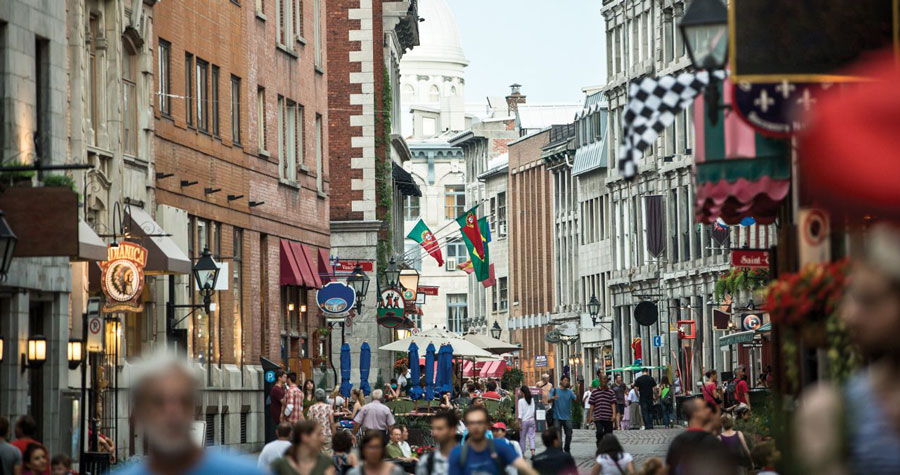B2. Population and Culture
Canada’s population is now just over 38 million, which is relatively small for a country of this size (Canada is the second-largest country in the world in terms of land mass). Much of Canada’s vast area is uninhabited and most Canadians live in highly urbanized centres in the south; 80% of the population is concentrated within 160 kilometres of the southern (US) border.
According to the last census in 2021, the largest Canadian cities are Toronto (6.2 million), Montreal (4.3 million), Vancouver (2.6 million), and Calgary (1.35 million) and Edmonton (1.3 million).

Canada is a multicultural and diverse country. The majority of Canadians are of European ancestry, primarily descendants of the early French and British colonists, as well as later immigrants from eastern and southern Europe.
However, as patterns of immigration have shifted over the years, so has the ethnic mix of the Canadian population. The second half of the twentieth century saw a great influx of people from Asia and Oceania, the Caribbean and South America, and Africa and the Middle East. In the 2016 Census, 40% of Canadians reported having one or more of 200 ethnic origins and over 19% of Canadians classified themselves as a visible minority. Over the past 150 years, Canada has welcomed 17 million immigrants from all around the world thanks to national policies supporting immigration and multiculturalism.
“Indigenous peoples” is a collective name for the original peoples of North America and their descendants. Indigenous peoples inhabited the land that later became Canada before European settlers arrived. The Canadian constitution recognizes three broad categories of Indigenous people: First Nations, Métis, and Inuit. These are three distinct groups of peoples who enrich the country with unique histories, languages, cultural practices, and spiritual beliefs. More than 1.5 million people in Canada identify themselves as an Indigenous person, according to the 2016 Census.
Canada has two official languages: English and French. English is the native language for 56% of the population and French is the native language for 20% (2016 Census, Statistics Canada). While the majority of Canada’s French speakers live in the province of Quebec, many live in New Brunswick (Canada’s only officially bilingual province), and Ontario. There are, however, smaller French-speaking communities all throughout Canada. Chinese dialects are the third most common native language in Canada, followed by Punjabi, Arabic, and Tagalog.
Many religions are practised in Canada, but about one quarter of Canadians say they have no religious affiliation. Canadians are remarkably tolerant of different religions, and religion does not play a prominent role in political or economic life relative to other parts of the world.
Culture

To many people in other countries, the word “Canada” evokes images of wide-open spaces, dramatic mountains, pristine forests, and majestic lakes. All of this is true, and our landscape and beauty are an important part of Canadian identity. But they’re not all of it.
Canada is also known to be a modern, progressive nation with open-minded citizens who are proud of our diverse origins and ethnic diversity. We produce athletes, artists, and engineers, doctors and architects, writers and scientists. There is a place for every type of talent in Canada, and the mix of people and specializations creates a vibrant, exciting society that’s secure but also dynamic and open to change
A few years ago one of Canada’s national newspapers, The Globe and Mail, interviewed various people about how they would sum up Canadian culture in an article entitled, “Canadian culture: A category?” One respondent, an immigrant to Canada, was quoted as saying:
“Canadians are very accepting people, very polite, very honest. It’s part of their culture. That’s why they accept new people. They are also more interested in other cultures these days. People like to try different foods, different ways of dress. They want to see the world and learn about new cultures. Not only do Canadians accept people into their country and their society, they accept aspects of other cultures into their own. Canadian society is composed of many different cultures, sharing their culture with each other. Canada is definitely multicultural. It’s also Canadian.”
With a country as large as Canada, there are also very different regional cultures: people in the Maritime region in the east of the country are quite different than those on the West Coast (e.g., in British Columbia). And Quebec, Canada’s majority French-speaking province, has its own unique customs and sense of identity (often deemed more “European” than the rest of Canada), with a rich arts, entertainment, and music scene. See more about regional culture in an upcoming section, Geography and Regions.
There are dozens of different sports played, among them hockey, lacrosse, baseball, basketball, and soccer (more commonly known as football outside of North America). Skiing, both downhill and cross country, is another national passion. Canada is home to every cuisine in the world: diners can choose anything from Indian, Thai, or Chinese to Ethiopian, Mexican, or French—to name a few.
Major national, regional, and international festivals and concerts either originate in or pass through Canada during the year, providing another wonderful benefit to studying in Canada.
Perhaps stemming in part from the rich culture and lifestyle Canadians enjoy, Canada placed 14th in the United Nations’ 2021 World Happiness Report. According to the Global Peace Index (20121) Canada is ranked in the top 10 most peaceful countries in the world, keeping company with the likes of Iceland, Denmark, and New Zealand. Canada regularly ranks in the top 12 on the United Nations’ Human Development Index, a comparative measure of life expectancy, literacy, education, standards of living, and quality of life.
When choosing a place to study, students often factor in culture and lifestyle as well as educational merits, whether their program is for a few weeks, months, or several years. For this reason, as well as the quality of education, Canada continues to rise as a destination for high-calibre students.
